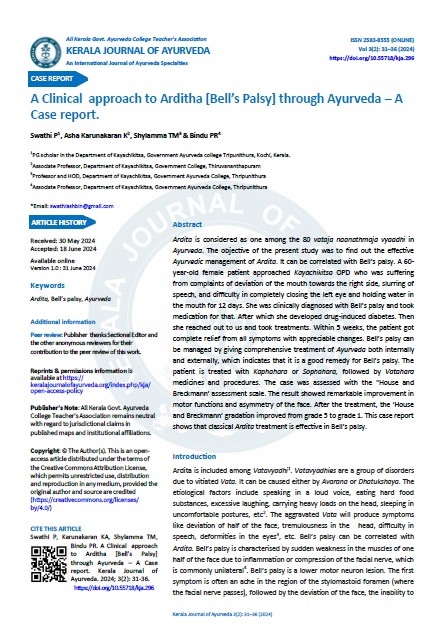A Clinical approach to Arditha [Bell’s Palsy] through Ayurveda – A Case report.
DOI:
https://doi.org/10.55718/kja.296Keywords:
Ardita, Bell’s palsy, ayurvedaAbstract
Ardita is considered one of the 80 vataja naanathmaja vyaadhi in Ayurveda. The objective of the present study was to find out the effective Ayurvedic management of Ardita. It can be correlated with Bell’s palsy. A 60-year-old female patient approached Kayachikitsa OPD who was suffering from complaints of deviation of the mouth towards the right side, slurring of speech, and difficulty completely closing the left eye and holding water in the mouth for 12 days. She was clinically diagnosed with Bell’s palsy and took medication for that. After which she developed drug-induced diabetes. Then she reached out to us and took treatments. Within 5 weeks, the patient got complete relief from all symptoms with appreciable changes. Bell’s palsy can be managed by giving comprehensive treatment of Ayurveda both internally and externally, which indicates that it is a good remedy for Bell’s palsy. The patient is treated with Kaphahara or Sophahara, followed by Vatahara medicines and procedures. The case was assessed with the "House and Breckmann’ assessment scale. The result showed remarkable improvement in motor functions and asymmetry of the face. After the treatment, the ‘House and Breckmann’ gradation improved from grade 5 to grade 1. This case report shows that classical Ardita treatment is effective in Bell’s palsy.
References
sarvanga sundara vyakhya of arunadutta. Ashtangahrdayam. In Nidana vatavyadhi: choukhambha sanskrit sansthan varanasi; p. sloka 32. (kashi sanskrit series).
sarvanga sundara vyakhya of arunadutta. Ashtangahrdayam. In Nidana vatavyadhi: choukhambha sanskrit sansthan varanasi; p. sloka 34. (kashi sanskrit series).
sarvanga sundara vyakhya of arunadutta. Ashtangahrdayam. In Chikitsa vatavyadhi: choukhambha sanskrit sansthan varanasi; p. sloka 43. (kashi sanskrit series).
Adams, Raymond D., and Maurice Victor. Principles of neurology, McGraw-Hill, Health Professions Division, New York, 5th edition 1993. Print, pp 1175-1177.
Chakrapanidutta revised by charaka and dridabala. charaka samhitha. In: by agnivesha. chikitsa 28: choukhambha sanskrit sansthan varanasi; p. sloka 99. (Mohandas Indological Series).
Chakrapanidutta revised by charaka and dridabala. charaka samhitha. In: by agnivesha. chikitsa 28: choukhambha sanskrit sansthan varanasi; p. sloka 38. (Mohandas Indological Series).
House-Brackmann Facial Paralysis Scale | Facial Paralysis Institute [Internet]. [cited 2024 Mar 13]. Available from: https://www.facialparalysisinstitute.com/conditions/house-brackmann-grading-system/
sarvanga sundara vyakhya of arunadutta. Ashtangahrdayam. In Chikitsa vatavyadhi: choukhambha sanskrit sansthan varanasi; p. sloka 43. (kashi sanskrit series).
sri chakrapanidutta. Charaka samhitha. In: ayurveda deepika vyakhya. suthrasthana. 20th chapter: chowkhamba krishnadas academy; p. sloka 20. (krishnadas ayurveda series 66).





